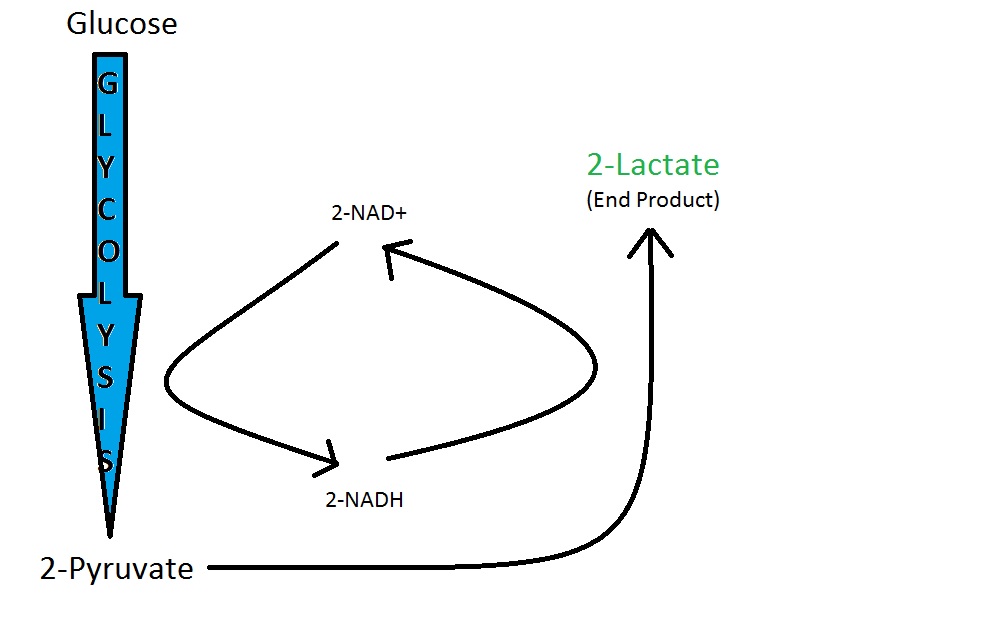Nutrition
Nutrition— The metabolic processes of S. pneumoniae are similar to
a large number other bacteria, in the fact that it uses
fermentation as its sole mechanism for metabolizing
carbohydrates (Carbohydrate Utilization, 2001). An
online book by Dr.
Kenneth Todar of the University of Wisconsin—Madison states that
S. pneumoniae is an
anaerobic bacteria that is aerotolorint (Todar, 2012). This means
that its ATP is produced by the fermentation of simple sugars
within the cell, much like you would find in organisms that live
in oxygen poor or inept environment. Though S. pneumoniae has an
anaerobic means of producing ATP, it is not limited to only
anaerobic environments. For example, Dr. Todar
states that only 20% of fresh clinical isolates for S. pneumoniae
required a fully anaerobic, zero oxygen, environment in order to
ferment properly (Todar, 2012). This ability to thrive in oxygen rich
and poor environments allows S. pneumoniae to
metabolism sugars almost anywhere giving it a massive
competitive edge over many other bacteria. This is an ability
that is common amongst many pneumonia causing bacteria and distinguishes
S. pneumoniae form other
bacterial groups.
Figure 1: Diagram of the fermentation process of glucose in an
anaerobic environment. Tanner Folvag 2013.
 The Importance of Enzymes-- As we have stated before on
our
CLASSIFICATIONS page,
S. pneumoniae is a member of a group known
as the lactic acid bacteria (LAB). LAB bacteria have a variety of
distinguishing features that are semi-unique to these bacteria. One
of the most important distinguishing features is their genetic
inability to encode for the enzyme catalase (Hoskins, et. al.,
2001). This inability to produce catalase (an enzyme used to break
down H2O2) largely determines the nutritional habits of the S.
pneumoniae bacteria because, as an anaerobe, it produces large
quantities of hydrogen peroxide as a by product of its metabolism
(Pericone, 2000). This inability to produce catalase naturally has
raised many questions amongst bacteriologist as to why bacteria, such
as S. pneumoniae, that produce hydrogen peroxide in such toxic amounts
can not diffuse the problem on their own (Pericon, 2000). This is why
S. pneumoniae must obtain the enzyme from its surrounding
environment. To metabolize sugars correctly and efficiently S.
pneumoniae bacteria prefers to live in places like the upper
respiratory systems due to the high abundance of catalase produced
by either the host or other bacteria living there as well (Gruner,
et. al., 2007).
The Importance of Enzymes-- As we have stated before on
our
CLASSIFICATIONS page,
S. pneumoniae is a member of a group known
as the lactic acid bacteria (LAB). LAB bacteria have a variety of
distinguishing features that are semi-unique to these bacteria. One
of the most important distinguishing features is their genetic
inability to encode for the enzyme catalase (Hoskins, et. al.,
2001). This inability to produce catalase (an enzyme used to break
down H2O2) largely determines the nutritional habits of the S.
pneumoniae bacteria because, as an anaerobe, it produces large
quantities of hydrogen peroxide as a by product of its metabolism
(Pericone, 2000). This inability to produce catalase naturally has
raised many questions amongst bacteriologist as to why bacteria, such
as S. pneumoniae, that produce hydrogen peroxide in such toxic amounts
can not diffuse the problem on their own (Pericon, 2000). This is why
S. pneumoniae must obtain the enzyme from its surrounding
environment. To metabolize sugars correctly and efficiently S.
pneumoniae bacteria prefers to live in places like the upper
respiratory systems due to the high abundance of catalase produced
by either the host or other bacteria living there as well (Gruner,
et. al., 2007).
Figure 2: Digital representation of the enzyme catalase. Jawahar Swaminathan, 2009.
What do S. Pneumonia like to eat?-- S. pneumonia requires a variety of mono- and polysaccharides as well as carbohydrates in order to obtain the carbon and energy it needs to continue growth (Lyer, 2005). Even though S. pneumonia is capable of utilizing a variety of sugars, not all sugars are created equal. This is to say that S. pneumonia make decisions to use one source of energy over another to optimize its energy yield (Lyer, 2005). The mechanism that regulates these selections is known as carbon catabolite repression (CR) (Paulson, 1996). This mechanism is very complex in S. pneumonia but primarily relies upon one key enzyme known as catabolite control protein A (CcpA) to govern the metabolic decisions of the bacteria. In a basic sense the CcpA enzyme has an affinity toward cretin types of simple and complex sugars. Once a highly preferred sugar is detected, the enzyme will shut off genes that code for proteins and other transport mechanisms designed for less preferred sugars (Rosenow, 1999). This shut down of non-essential genes allows for a much more efficient metabolism of more useful sugars, thus yielding more energy (Lyer, 2005). A study conducted in 2005 by Dr. Carsten concluded that S. pneumonia’s most preferred simple sugar is in fact sucrose (Rosenow, 1999).
